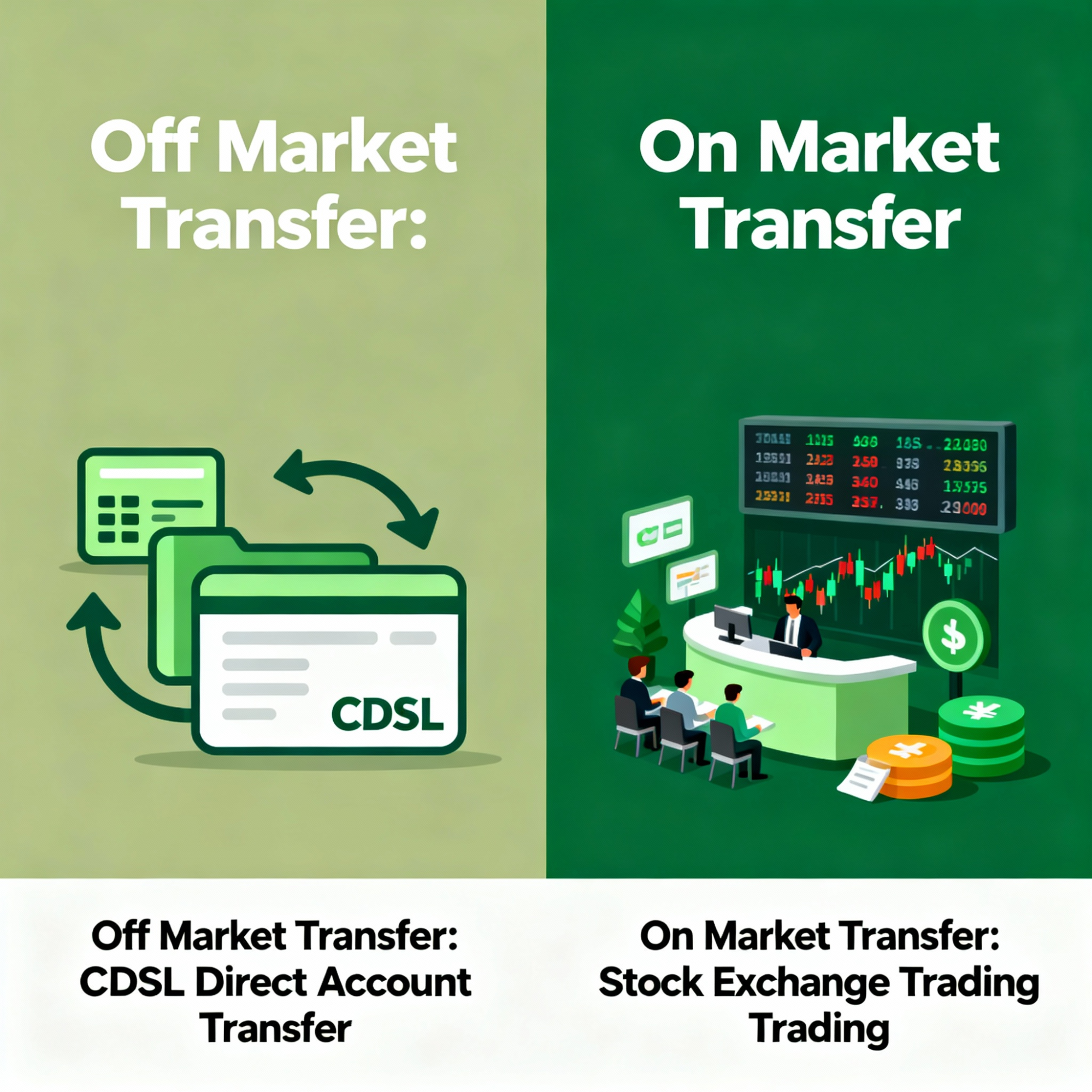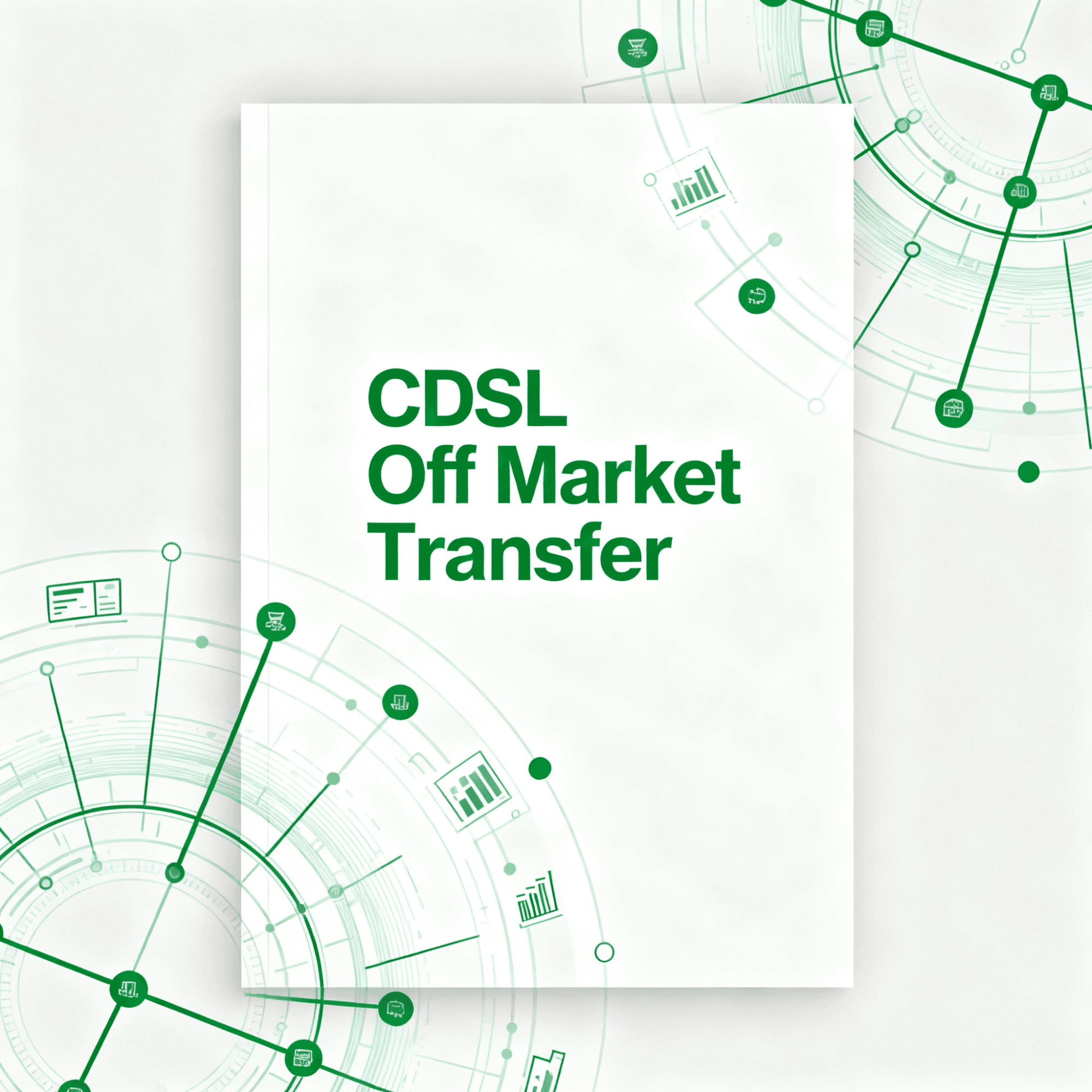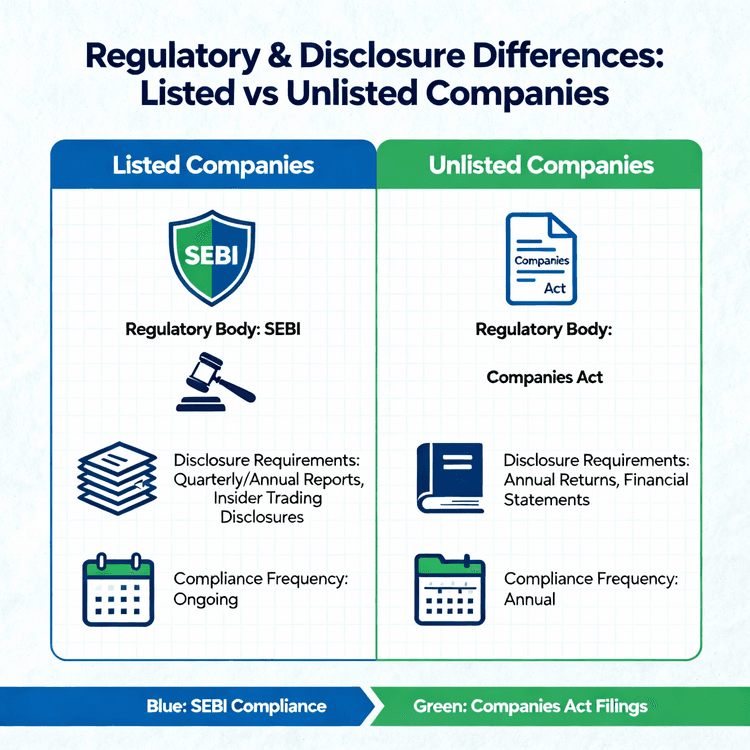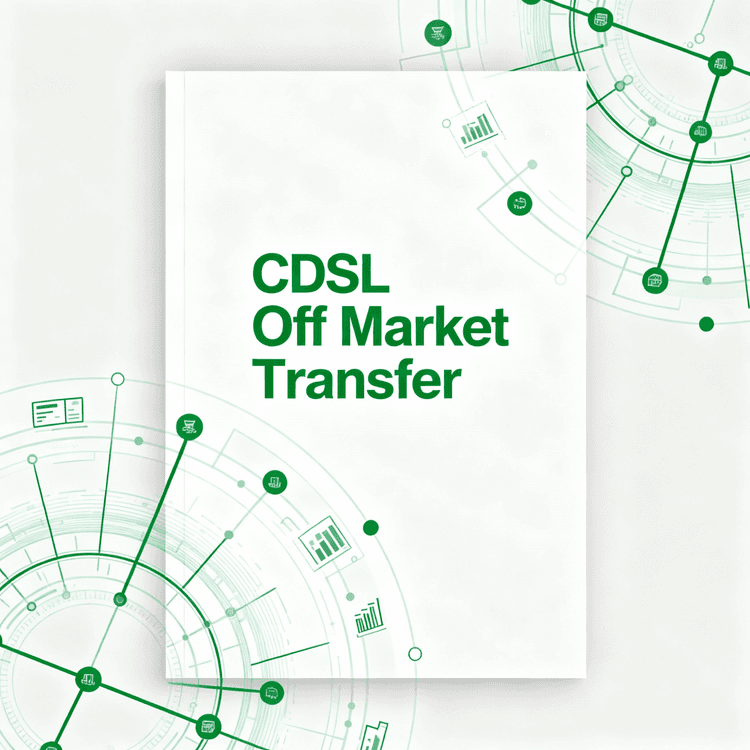What Is CDSL Off Market Transfer
A CDSL Off Market Transfer refers to the direct transfer of securities between two demat accounts within the Central Depository Services Limited (CDSL) ecosystem without executing any trade on the stock exchange platform. Unlike on-market transactions that involve buying and selling through stock exchanges, off-market transfers facilitate the movement of existing securities from one Beneficiary Owner (BO) account to another BO account for various non-trading purposes.
The procedure is purely in the depository system of CDSL, and this allows investors to sell shares and bonds among other securities directly to family members, friends, or other parties without determining the market price and without involving the exchange. This is especially useful in transfers of gifts, settlement of inheritance, consolidation of accounts, unlisted securities or shares in privately held companies that are not necessarily actively traded on a stock exchange.
CDSL supports off-market transfers in two main ways; via the classic Delivery Instruction Slip (DIS) system that is provided to Depository Participants and via the digital Easiest CDSL platform enabling the transfer of securities paperlessly and securely online with multi-factor authentication, including OTP and TPIN verification. The electronic system has transformed the off-market transfer by avoiding the use of physical paperwork but with strong security measures to avoid illegal transfer.
When Do Investors Use Off Market Transfer
Off-market transfer has a variety of uses in the portfolio management policy, and in the life of the investors. The most prevalent would be the transfers of gifts between members of a family, with parents selling shares to children, couples selling securities to one another or family members funding one another via equity without any market dealings. This mechanism retained the original basis of purchase and does not incur unwarranted costs of brokerage.
Another very important use case is in inheritance and estate planning where securities owned by deceased investors are handed over to legal heirs after due process of succession. Off-market transfers simplify the process by not having to go through the tedious process of selling shares in the market only to later buy them in the names of beneficiaries, a process that would incur two times transaction costs and possibly taxation.
Off-market transfer is commonly used in account consolidation activities where investors will have several demat accounts with more than one broker and desire to manage the accounts to consolidate holdings in a single account to manage the portfolio better. This is especially typical when the investors change brokers or desire to make the accounts cheaper by terminating the unnecessary accounts.
The transfers of unlisted and privately owned company securities engage mainly off-market means because these securities are not traded in an exchange. Off-market transfers are the only method of transfer that should be used by investors transacting in pre-IPO shares, in a private placement, in stock options granted to an employee or in shares of a not-yet-public company.
Step-by-Step Process for CDSL Off Market Transfer
The Easiest platform has made the process of CDSL off-market transfer easier without compromising on the security measures. The process starts with the registration and establishment of the trust where the transferor needs to include the demat account of the transferee as a beneficiary on CDSL Easiest and qualify it as a trusted account. This is a compulsory procedure that is designed to avoid illegal transfers, and it is activated in 24 hours and is the first level of protection.
Platform access and authentication involves logging into the CDSL Easiest portal (web.cdslindia.com/myeasitoken/home/login) using registered credentials. Users must navigate to the 'Transaction' section and select 'Setup' followed by 'Bulk Setup' for multiple securities transfers or individual setup for single security transfers.
Transaction details configuration requires entering the beneficiary's 16-digit BO ID, selecting the execution date, and setting the Entity Identifier as 'NA' for standard transfers. Users then select securities from their holdings by choosing relevant ISIN codes, specifying transfer quantities, and selecting appropriate transfer reasons from CDSL's predefined dropdown list.
The stamp duty treatment and consideration is also important in transfers which involve monetary consideration. Where the transfers form sale or purchase transactions, users will be required to involve the amount of sales, details of payments and payment of applicable stamp duty online before submissions. Calculation of the stamp duty is in the form of prescribed slabs by the government depending on the value of the transactions and the state regulations.
Authentication and authorization is the last phase in which transferors have to validate transactions by OTP on registered mobile numbers and email addresses, and need to include their CDSL Easiest PIN. This two-factor authentication verifies the security of the transaction and secures unauthorized access.
The processing and settlement are made according to the timing when submission occurred, submissions made before 6 PM on a trading day are usually processed the same day and those submitted later are processed the following day. Successful processing of the system automatically debits the securities in the account of the transferor and credits the securities in the account of the transferee.
Documents Required for Off Market Transfer
The main records of off-market transfer focus on the Delivery Instruction Slip (DIS) of more traditional paper-based transfers or the electronic authentication of Easiest platform users. DIS forms should be duly completed with correct beneficiary, transfer amounts and signed by all holders of demat account. A DIS may only hold a maximum of five securities (ISINs), with other securities having to be provided using supplementary DIS Annexure forms.
When new beneficiaries that are not registered as trusted accounts are being added as beneficiaries, they are required to provide their beneficiary identification documents (Annexure A forms are used). This paper will need full beneficiary details such as BO ID, PAN number and contact information, and should be accompanied by identity verification documents in order to form the relationship of the beneficiary.
Transfer involving monetary transfer will necessitate consideration related documentation. Off-market sales forms should also include payment details, bank account details of transferor and transferee and evidence of consideration payment. Such documents are required to be in line with regulatory requirements and allow calculating stamp duties correctly.
Corporate compliance forms are also required in the event of the transfer of company shares that are privately owned, as per the recent amendments to the regulations. A company has to have prior consent letters in prescribed formats prior to transfer execution; this is a huge change considering the previous regime where companies only find out about transfers after the execution through BENPOS reports.
Identity and authorization proofs include valid KYC documents, PAN cards, and address verification for both parties. Digital transfers through Easiest require registered mobile numbers and email addresses for OTP verification, while traditional transfers may require additional signature verification documents.
Charges Applicable on CDSL Off Market Transfer
Transfer fees structure follows a per-security basis rather than per-share calculation, with CDSL charging ₹25 per security per transaction plus 18% GST. This means transferring 100 shares each of three different companies (300 total shares) attracts charges of ₹88.50 (₹25 × 3 + 18% GST), while transferring 300 shares of a single company costs only ₹29.50 (₹25 × 1 + 18% GST).
Stamp duty liability or requirement is placed on transfers involving consideration or deemed consideration that is calculated based on the rates as prescribed by governments relative to both state and transaction value. The stamp duty has to be paid online during the transfer procedure, the rate depends on the transaction value and the jurisdiction of the country, as well as the particularities is usually between 0.015 and 0.1% of transactions.
Depository Participant fees could provide extra processing fees, service charges or handling charges according to individual DP tariff programmes. These fees are really different in the DPs and must be confirmed first to initiate transfers to avoid unwanted expenses.
Other compliance expenses can be document verification, video verification of transfer exceeding 5 lakhs, and payment to courier to submit physical documents in the conventional modes of transfer.
Difference Between Off Market and On Market Transfer

The difference in the mechanism of execution is the essence of these types of transfers. The off-market transfers are direct inter-demat account transfers within the system of CDSL and the on-market transfers are part of exchange-based transactions in which securities are transferred between each other at prices set by the market.
The two methods have a lot of variation in regard to pricing and consideration. Off-market transfers enable parties to agree to any amount of consideration or even make a gift transfer free of consideration whereas on-market transfers have to be undertaken at current market prices established by exchange order matching systems.
Settlement times will show various structures of operations, off-market transfers tend to settle in a one to two working days depending on the time they have been submitted, whereas on-market transfers are governed by the standardized T+2 settlement cycle required of an exchange transaction.
The regulatory compliance rules vary significantly, with off-market transfers subject to the transfer regulations of CDSL and the stamp duties regulations, whilst on-market transfers are subject to extensive stock exchange regulations, SEBI trading regulations and market conduct regulations..
Risks and Precautions to Consider
Off-market transfers are prone to fraud and security risk especially when the demat account credentials are lost or where the transferors are victims of a social engineering attack. The 24-hour trusted beneficiary activation and the two-factor authentication (OTP and PIN) offer the necessary security measures, yet investors have to be careful of phishing and unauthorized access.
The mistakes in the execution of transactions may be caused by the inaccurate beneficiary BO ID, incorrectly selected ISINs, or errors in the quantity that lead to failures in transfer or incorrectly directed securities. These mistakes can lead to delays, extra fees, and possible conflicts which have to be solved by formal methods.
There are Liquidity and valuation issues when transferring shares which are not currently quoted in the market, and this could give rise to a disagreement about a fair valuation of consideration based transfers or a tax implication based on the fair market value and not the agreed amount of consideration.
Delays and rejection may arise because of the lack of sufficient funds to make charges, the incompleteness of the documentation, or the technical failure of the Easiest platform. To reduce these risks, investors are advised to maintain a sufficient balance in the funds, full documentation and alternative transfer procedures
Conclusion
CDSL Off Market Transfer represents a crucial facility enabling efficient, secure transfer of securities between demat accounts for various non-trading purposes. The evolution from paper-based DIS systems to the digital Easiest platform demonstrates CDSL's commitment to modernizing investor services while maintaining robust security protocols. Understanding the comprehensive process, documentation requirements, applicable charges, and associated risks empowers investors to utilize this facility effectively for gift transfers, inheritance settlements, account consolidation, and unlisted securities transactions.
The distinction between off-market and on-market transfers highlights the specialized nature of this facility, designed to complement rather than replace exchange-based trading mechanisms. Recent regulatory developments, particularly regarding private company share transfers, underscore the importance of staying updated with evolving compliance requirements to ensure smooth transaction execution.
Successful utilization of CDSL off-market transfers requires careful attention to beneficiary registration, accurate documentation, timely submission, and adequate fund maintenance for applicable charges. As digital platforms continue enhancing user experience and security features, off-market transfers will remain an essential tool for investors managing diverse portfolio requirements and life event-driven securities movements within India's evolving capital markets infrastructure.




